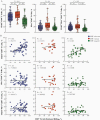Correlation Between TIGIT Expression on CD8+ T Cells and Higher Cytotoxic Capacity
- PMID: 33744939
- PMCID: PMC8599894
- DOI: 10.1093/infdis/jiab155
Correlation Between TIGIT Expression on CD8+ T Cells and Higher Cytotoxic Capacity
Abstract
Persistent exposure to antigen leads to T-cell exhaustion and immunologic dysfunction. We examined the immune exhaustion markers T cell immunoglobulin and ITIM domain (TIGIT) and programmed cell death protein 1 (PD-1) in human immunodeficiency virus (HIV)-infected and healthy individuals and the relationship with cytotoxic CD8+ T-lymphocyte activity. Frequencies of TIGIT but not PD-1 were positively correlated with CD8+ T-lymphocyte activity in HIV-aviremic and healthy individuals; however, there was no correlation in HIV-viremic individuals. Transcriptome analyses revealed up-regulation of genes associated with antiviral immunity in TIGIT+CD8+ versus TIGIT-CD8+ T cells. Our data suggest that TIGIT+CD8+ T cells do not necessarily represent a state of immune exhaustion and maintain an intrinsic cytotoxicity in HIV-infected individuals.
Keywords: TIGIT; cytotoxic T lymphocytes; human immunodeficiency virus; immune exhaustion.
Published by Oxford University Press for the Infectious Diseases Society of America 2021.
Figures


Similar articles
-
Delayed Expression of PD-1 and TIGIT on HIV-Specific CD8 T Cells in Untreated HLA-B*57:01 Individuals Followed from Early Infection.J Virol. 2020 Jul 1;94(14):e02128-19. doi: 10.1128/JVI.02128-19. Print 2020 Jul 1. J Virol. 2020. PMID: 32350076 Free PMC article. Clinical Trial.
-
Inverted CD8 T-Cell Exhaustion and Co-Stimulation Marker Balance Differentiate Aviremic HIV-2-Infected From Seronegative Individuals.Front Immunol. 2021 Oct 12;12:744530. doi: 10.3389/fimmu.2021.744530. eCollection 2021. Front Immunol. 2021. PMID: 34712231 Free PMC article.
-
Perturbed CD8+ T cell TIGIT/CD226/PVR axis despite early initiation of antiretroviral treatment in HIV infected individuals.Sci Rep. 2017 Jan 13;7:40354. doi: 10.1038/srep40354. Sci Rep. 2017. PMID: 28084312 Free PMC article.
-
CD155/TIGIT, a novel immune checkpoint in human cancers (Review).Oncol Rep. 2021 Mar;45(3):835-845. doi: 10.3892/or.2021.7943. Epub 2021 Jan 19. Oncol Rep. 2021. PMID: 33469677 Review.
-
TIGIT signaling and its influence on T cell metabolism and immune cell function in the tumor microenvironment.Front Oncol. 2023 Feb 17;13:1060112. doi: 10.3389/fonc.2023.1060112. eCollection 2023. Front Oncol. 2023. PMID: 36874131 Free PMC article. Review.
Cited by
-
Immune mobilising T cell receptors redirect polyclonal CD8+ T cells in chronic HIV infection to form immunological synapses.Sci Rep. 2022 Nov 1;12(1):18366. doi: 10.1038/s41598-022-23228-3. Sci Rep. 2022. PMID: 36319836 Free PMC article.
-
T cell specific deletion of Casitas B lineage lymphoma-b reduces atherosclerosis, but increases plaque T cell infiltration and systemic T cell activation.Front Immunol. 2024 Mar 4;15:1297893. doi: 10.3389/fimmu.2024.1297893. eCollection 2024. Front Immunol. 2024. PMID: 38504977 Free PMC article.
-
Nectin Family Ligands Trigger Immune Effector Functions in Health and Autoimmunity.Biology (Basel). 2023 Mar 15;12(3):452. doi: 10.3390/biology12030452. Biology (Basel). 2023. PMID: 36979144 Free PMC article. Review.
-
TIGIT regulates CD4+ T cell immunity against polymicrobial sepsis.Front Immunol. 2024 Mar 13;15:1290564. doi: 10.3389/fimmu.2024.1290564. eCollection 2024. Front Immunol. 2024. PMID: 38545097 Free PMC article.
-
Dynamic Expressions of TIGIT on Splenic T Cells and TIGIT-Mediated Splenic T Cell Dysfunction of Mice With Chronic Toxoplasma gondii Infection.Front Microbiol. 2021 Aug 5;12:700892. doi: 10.3389/fmicb.2021.700892. eCollection 2021. Front Microbiol. 2021. PMID: 34421855 Free PMC article.
References
Publication types
MeSH terms
Substances
LinkOut - more resources
Full Text Sources
Other Literature Sources
Medical
Research Materials

